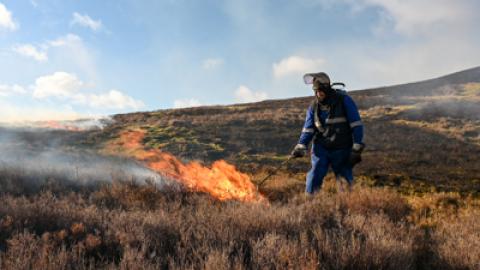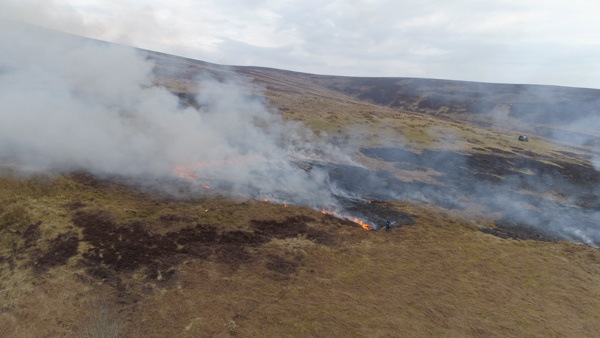
This research compares the impacts of heather moorland managed by muirburn versus by brushcutting. This trial has focussed on studying early changes in carbon stocks, plant litter decomposition and soil nutrient availability.
The trial plots also provide the opportunity for further study of treatment impacts on soil carbon, biodiversity and future wildfire risk, as well as offering a platform for comparative research to other researchers and sites conducting burning and cutting trials.
Background:
Heather (Calluna vulgaris (L.)  Hull)-dominated moorland has high conservation importance with a native distribution within Europe and heather moorlands are a dominant habitat of the UK uplands. Heather moorland vegetation is traditionally managed through prescribed burning, in Scotland this is known as ‘muirburn’ and involves burning small patches of old heather (~30 m wide strips) on a 10 to 25 year rotation, to create a mosaic of different aged heather to benefit red grouse and/or livestock.
Hull)-dominated moorland has high conservation importance with a native distribution within Europe and heather moorlands are a dominant habitat of the UK uplands. Heather moorland vegetation is traditionally managed through prescribed burning, in Scotland this is known as ‘muirburn’ and involves burning small patches of old heather (~30 m wide strips) on a 10 to 25 year rotation, to create a mosaic of different aged heather to benefit red grouse and/or livestock.
At Glensaugh there has been a long history of research on the use and impacts of muirburn. For example, controlled burns have been measured in detail for fuel loads and flammability properties to assess Fire Danger Rating Systems. Glensaugh was also used for an experiment looking at the impacts of burning under appropriate and too dry conditions. Burning during a drought resulted in higher fire severity, increased soil temperatures in summer and decreased them in winter, reduced soil respiration for the first six months and altered the composition of the regenerating vegetation. The work was done by Dr. Noemi Naszarkowski as part of her PhD “Wildfire impacts on Scottish Upland Ecosystems” at Aberdeen University.
Muirburn has become subject to stronger regulation following Wildlife Management and Muirburn (Scotland) Act. There are concerns around the contribution of muirburn to the current climate crisis as burning heather releases vegetation carbon into the atmosphere and biodiversity. At the same time, without burning, vegetation biomass could accumulate and provide fuel for larger and more intense wildfire, which in the end release greater amounts of carbon from both the vegetation and underlying organic and peat soils. Research is needed to explore the impact of alternative moorland vegetation management practices, such as cutting heather vegetation.
Our most recent research as part of the Scottish Government's Rural and Environmental Science and Analytical Services (RESAS) 2022–2027 Strategic Research Programme has established trial plots comparing impacts of heather moorland managed by muirburn and brushcutting. This trial has been studied in relation to early changes in carbon stocks, plant litter decomposition and soil nutrient availability. The trial offers a platform for comparative research to other sites conducting burning and cutting trials and for further study on treatment impacts on soil carbon, biodiversity and future wildfire risk.
Contact
Stuart Smith: staff page email
